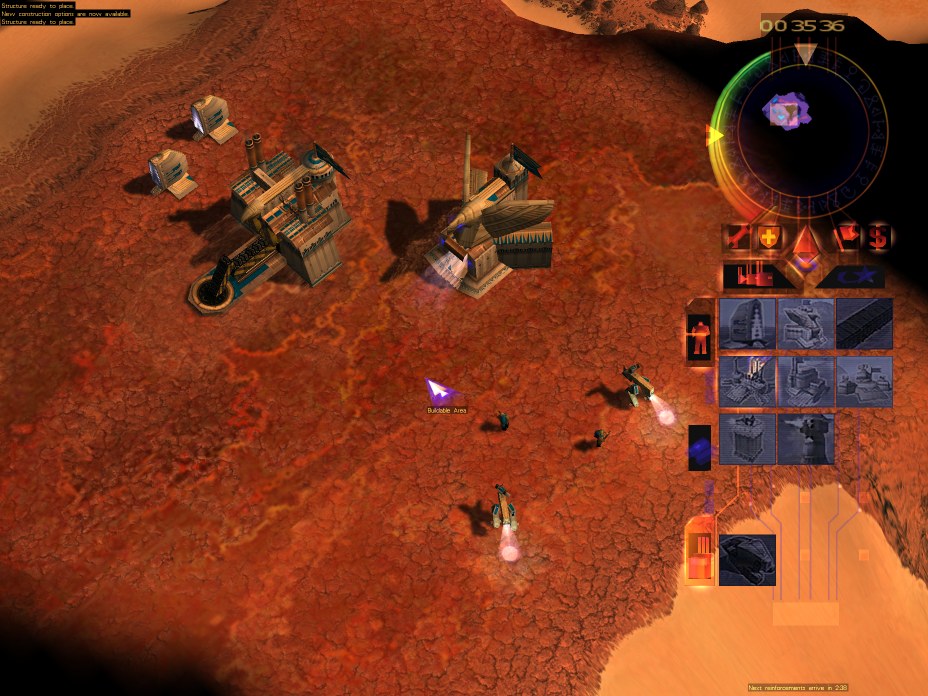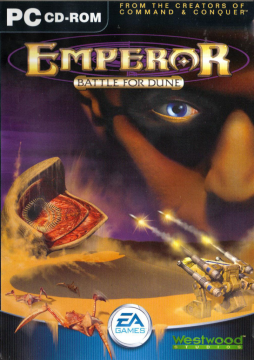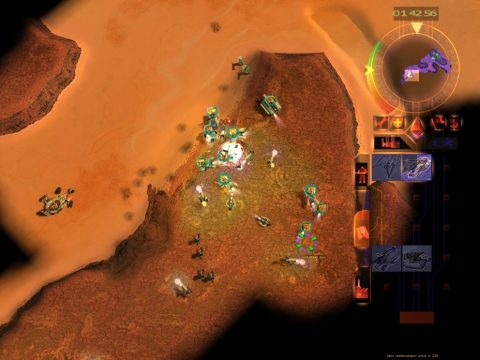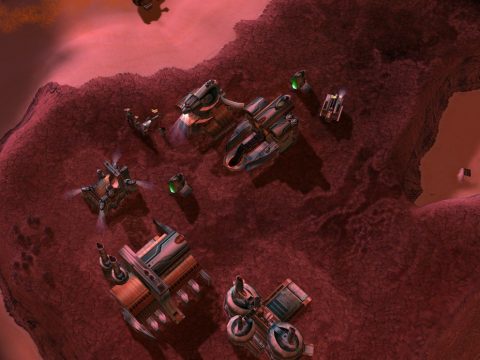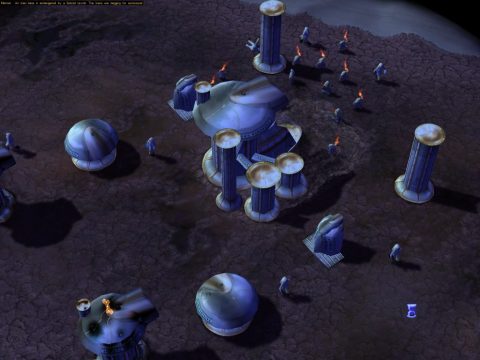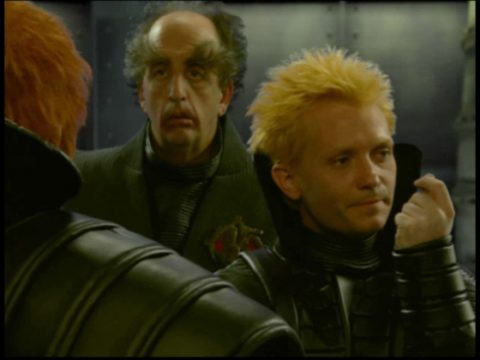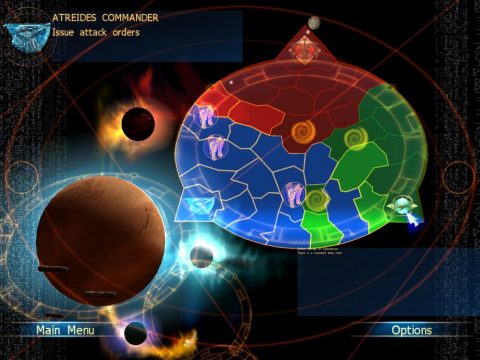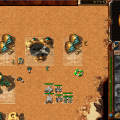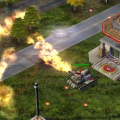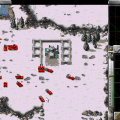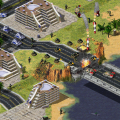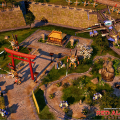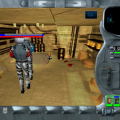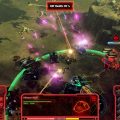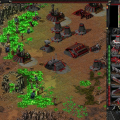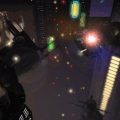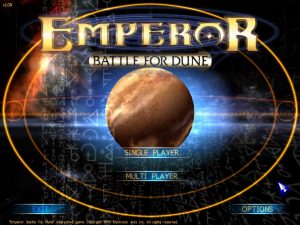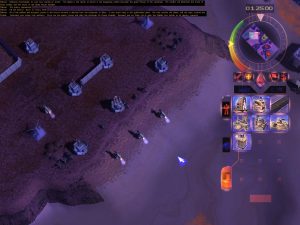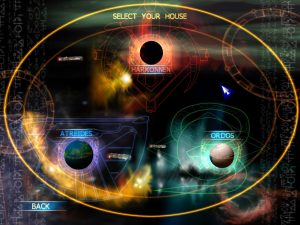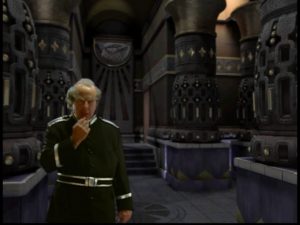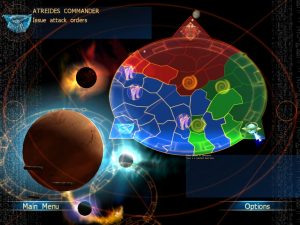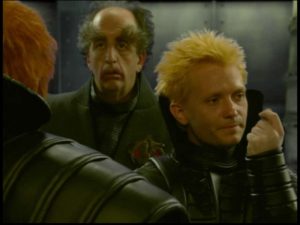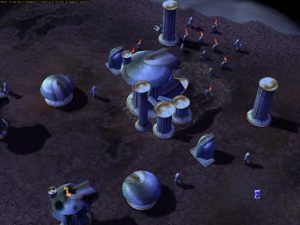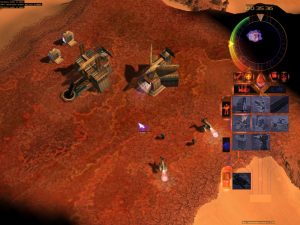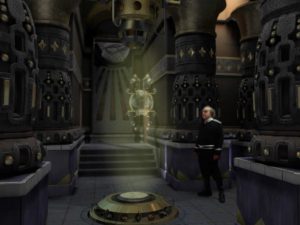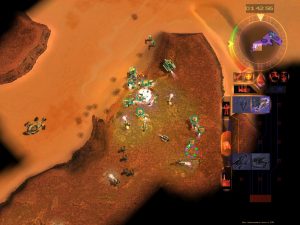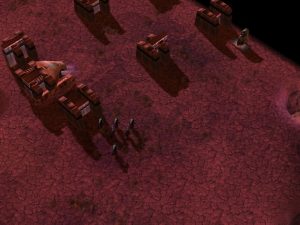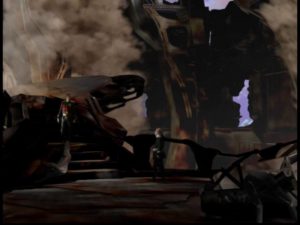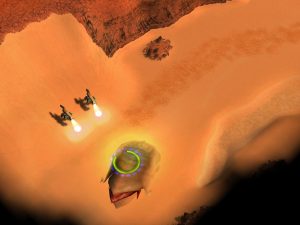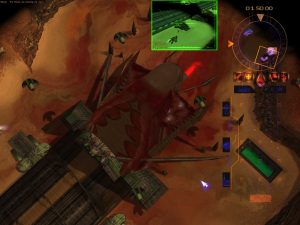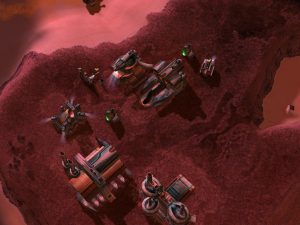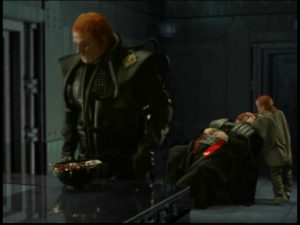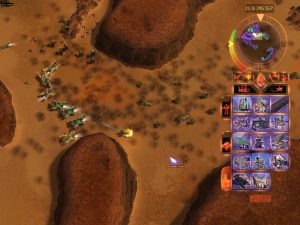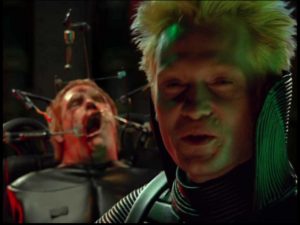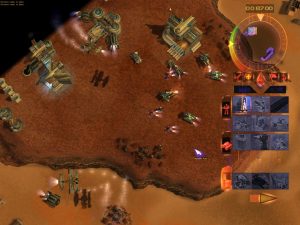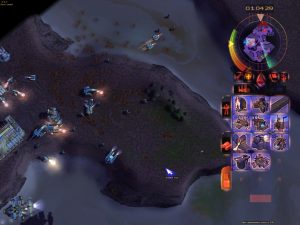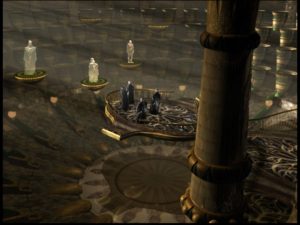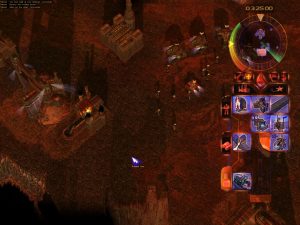- Dune
- Dune II: The Building of a Dynasty
- Dune 2000
- Emperor: Battle for Dune
- Behind the Dune
The release of Dune 2000 did not moved the Dune series or its Command & Conquer sibling forward. Three years later, that would change. Co-developed by Westwood and Intelligent Games, Emperor: Battle for Dune was released. Powered by the W3D engine, it was Westwood’s first 3D game. W3D was supposed to be used for Command & Conquer 3: Incursion, the sequel to Command & Conquer: Tiberian Sun. Command & Conquer 3: Incursion never saw the light of day for various reasons and was eventually replaced by Command & Conquer 3: Tiberium Wars. However, W3D was utilized for the spin-off title Command & Conquer: Renegade. Graphical changes aside, the basic gameplay formula in Emperor: Battle for Dune was left intact, and once more, full-motion video sequences were used to advance the story.
After an apparent pyrrhic Ordos victory on Arrakis, Lady Elara, concubine to Emperor Shaddam Corrino, poisons the Emperor. The Emperor’s death throws the Imperium into chaos. The Spacing Guild, the sole provider of interstellar travel and highly reliant on Spice, steps forward and makes a suggestion: a war of assassins is to be fought on Arrakis between Houses Atreides, Harkonnen, and Ordos. The war is limited to the planet, and the use of nuclear weapons is prohibited. The winner will gain control over Arrakis and the imperial throne. The three Great Houses agree, and thus the war continues.
If Dune 2000 shared visual similarities with the David Lynch adaptation, Emperor: Battle for Dune almost gives the impression that Westwood nicked its sets and costumes. The Harkonnen and Atreides troopers look exactly like they did in the film adaptation, down to the gas masks and khaki uniforms, respectively. Baron Rakan Harkonnen and his two sons resemble Vladimir Harkonnen and his nephew both in looks and personality. The same is true for the bald Gene Gesserit sisters and Spacing Guild members, the Sardaukar troopers, the Emperor – once more played by Adrian Sparks – and other sets and actors. The acting is somewhat exaggerated and campy. This is on par with the performance of Westwood actors in previous Command & Conquer games and probably for the better – an attempt at a more sober performance probably would have given the impression of the game taking itself too serious. The cutscenes are enjoyable and have a good sense of drama, and the comparably low resolution of the videos covers up some of the CGI flaws.
New is the way the campaign is structured. The strategic Dune map from Dune II: The Building of a Dynasty and Dune 2000 is back, but this time, it does more than illustrate the campaign progress. Instead, the player can choose whichever territory they want to invade next, provided it borders a territory currently under player control. The goal is to reach and conquer one of the enemy capitals. Once that has been taken over, the player house invades the home planet of the respective house before return to Dune for the final battle. Each territory has its own map, often with unique features such as neutral structures, custom assets to add variety to the wastelands of Dune, valuable scrap and recruitable units scattered over the map, and more. Should a player visit the same map twice, they retain their base in parts (provided the last battle was successful) and whatever part of the shroud of war they explored. Debris and craters stay as well, giving the feeling that Arrakis truly is a battlefield. On top of that, not every battle needs to be won. A player can retreat or give up a territory that is under attack. Should they do that too often, they will lose the campaign, but Emperor: Battle for Dune does not make every single fight a battle that must be won.
Before invading a territory, a player should consider how many friendly and hostile territories it borders. Each of these neighboring territories will send reinforcements for their respective side. These can stack up quickly and sometimes determine the outcome of the battle. Should a reserve army be nearby, it will provide all units of the assault force with veterancy. Territories ravaged by sandstorms cannot be attacked. Furthermore, most maps have a random event, which prevents them from being a series of skirmish-like matches. Allies need help and provide a reward if they get it. The enemy may receive extra troops. Non-aligned hostile units haunt the territory. A smuggler base is present. There are many events, and most of them are specific to a certain house and respect their general philosophy.
Furthermore, there are a couple of scripted missions. Each house has its own tutorial mission. After one battle of the player’s choice, they are sent to a Spacing Guild heighliner, an immense spacecraft used to transport smaller craft between stars. Here, the Ordos leak gas into the ventilation system, the Harkonnen blow up enemy frigates in an act of terrorism, and the Atreides defend their frigates – while destroying some of the hardware of the enemy houses. By accident, of course. After a couple more regular fights, the player is taken to their house’s homeworld. As the Atreides commander, they have to defend Duke Atreides and his Fremen guests. The Ordos need to deal with an outbreak of contagious biomechanical creatures. The Harkonnen mission is especially interesting: Copec, the older and less intellectually sophisticated brother, poisons his father and declares himself to be the new Baron. Gunseng, who oversees the operations on Dune, is having none of this. Civil war breaks out, and the player can support either brother. Unfortunately, this merely leads to a couple different cutscenes.
In addition to the campaign structure, the units of the various houses were overhauled. The only units that all houses share are the construction vehicle, the Spice harvester, the engineers, the scout, and the carryall. The Atreides have access to basic infantry, mortar troopers, and snipers. Their arms factory produces the sand bike, a scout unit, the versatile Mongoose, a walker that can attack both ground and air targets, and the slow but powerful and long-ranged Minotaurus. Also available as a stealthed APC and a repair vehicle. Their air units are the assault ornithopter, which is especially useful against the AI, and an air defense drone, an unmanned craft be used against other air targets. The Atreides high-end unit is once more the sonic tank, which, while very powerful, still has the unfortunate habit of disintegrating its friends as quickly as its foes. Provided by the Atreides palace is the Hawk Strike support power. A unit hit by the Hawk Strike flees in terror, which is only a minor inconvenience – until a fleeing unit reaches the end of the map and disappears forever. The Atreides also have a special ability: an Atreides veteran soldier can be send back into their barracks and act as an instructor. Thereafter, the barracks will produce veteran units.
The Harkonnen have no such ability. Instead, they have the toughest units. Even if damaged, they will no slow down. On the other hand, Harkonnen units cannot be repaired and never regenerate, unless they reach maximum veterancy. In tune with their theme of being evil and generally nasty, the Harkonnen barracks trains flamethrower infantry in addition to riflemen and rocket soldiers. Courtesy of the arms factory are a giant piloted buzz saw that slices through Spice and human bodies as well as the boring but practical assault tank and rocket launcher. New are the flame tank, which burns infantry swiftly and painfully, and the Inkvine catapult. Based on a throwaway line from the novels, it fires barrels of Inkvine, a corrosive substance. The Devastator also makes a return. Now a walker, it can fire at air and ground targets, which makes its role more similar to that of the Command & Conquer Mammoth and Apocalypse tanks. Unfortunately, the Devastator went from being painfully slow to being unfathomably slow. Unless transported by a carryall, it serves best as a mobile base defense. Also available is a gunship that, while slower than its Atreides sibling, is heavily armored. Lastly, the Death Hand missile makes a return. Once the ultimate destroyer of bases, it is now a moderately exciting glorified radioactive firecracker.
The Ordos are still the faction with the lightest and fastest units. The core of their army is the laser tank, a highly mobile tank that can fire on the move. Like a couple of other Ordos units, it is shielded. Shield regenerate over time. However, if hit by a laser weapon, both attacker and shielded defender explode. This is lifted straight from the Frank Herbert novels – without the explosion being equal to a thermonuclear detonation, that is. The laser tank is accompanied by the anti-infantry dust scout as well as a shielded APC and the Kobra, a deployable artillery piece that finally gives the Ordos native access to long-ranged weaponry. The mind-controlling Deviator returns as well, and is a little bit more useful than it used to be. From the barracks, the gas trooper, mortar soldier, and AA trooper join the fight alongside the saboteur. The latter is no longer a high-end unit, and more along the lines of the average RTS suicide unit. A saboteur can also be dropped by the eye in the sky, a slow and overpriced air unit. The Ordos have no equivalent to the Atreides and Harkonnen gunships, but can defend themselves against such units with AA mines, another suicide unit. Newly provided by the Ordos palace is the Chaos Lightning, an electrical discharge that causes units to turn on one another – devastating if used against concentrated enemy forces.
As it was the case with the previous Dune games, all three houses share most of their buildings, and only a few changes have been made to the building roaster. In tune with changes the Command & Conquer series made, the light and heavy factory were merged. Spice refineries can now be upgraded, encouraging the player to build less refineries overall. All three houses now have different and thematically appropriate base defenses. The Atreides use a gun and rocket turret, the Harkonnen a flame tower and machine gun turret, and the Ordos defend themselves with war gas. New in Emperor: Battle for Dune are five smaller factions. Back are the Fremen, who provide camouflage infantry. The Sardaukar, ready the strongest house on Dune, offer the player with heavy infantry. The technologically sophisticated Ixians have a projector that creates illusionary units and a suicide scout. Their bitter rivals, the Tleilaxu bioengineers, have the zombie-like Contaminator and the Leech, two units which turn infantry and vehicles into more copies of themselves. Lastly, there is the Spacing Guild, which comes with a super long-range cannon, sandworm-like Makers that shoot lightning, and teleporting tanks. During the campaign, the player can ally with these factions via certain events, with the exception of the Spacing Guild. This, combined with the semi-linear campaign, adds a nice bit of variety to repeated playthroughs.
Despite the changes Emperor: Battle for Dune makes compared to its predecessors, the game is not without issues. On a technical level, the game works mostly fine, but suffers from poor pathfinding. The AI is generally competent (and even builds walls), but nevertheless flawed. It never explores maps properly and leaves all neutral units for the player to recruit. The same goes for the scrap. A piece of scrap is worth 2,000 credits – almost half a standard starting budget and a huge economic boost. On some maps, the player starts next to multiple pieces of scrap, which then provide them with enough money to roll over the AI without even building up their economy. Even better, the scrap respawns if the map is revisited. Another weakness of the AI is its inability to defend itself against rushes. Whenever the AI attacks a player territory, they start – just like the player would – with a construction vehicle and a handful units. The player, who starts with a small base, can crush them in a minute or two more often than not. If that does not work out, ornithopters and gunships with do the job, as the AI never, ever constructs adequate anti-air defenses. Likewise, the AI cannot deal with the contagious Tleilaxu units.
Another great idea followed by lackluster execution are the events and side missions. While they spice up the otherwise sameish battles, they are often not worth perusing. Some events take too long to trigger, and when they do, the battle is already over. Others require an investment in resources that is simply not worth the reward. Especially annoying are some of the side missions of the final act. They often involve the Tleilaxu Leech units. Preventing units from being infected or healing infected units is a huge pain and strongly incentivizes the player to end each battle as quickly as possible before the obnoxious Tleilaxu units show up. Yet another reason to not remain on any map for too long is Emperor: Battle for Dune’s Spice economy. In Dune 2000 and previous Command & Conquer games, building multiple copies of the same production structure increased the build speed of a unit or building. Command & Conquer: Generals did away with that, but instead features parallel production queues. Emperor: Battle for Dune has neither and a de facto cap on the speed at which the player can expand their army. Halfway through a battle, this often leads to a stalemate, which in turn once more encourages rush and cheese tactics.
Despite all of its shortcomings, Emperor: Battle for Dune brings some fresh ideas to the table and remains somewhat unique in its approach to the real-time strategy genre even years after its release. It was the last of its kind, as the Frank Herbert estate declined to license further Dune video games after Emperor: Battle for Dune and only authorized the development of Frank Herbert’s Dune, a stealth action game based on the miniseries of the same name. In spirit, the Dune series would live on via its Command & Conquer sibling, the series it laid the foundation for and that eventually overshadowed it.
